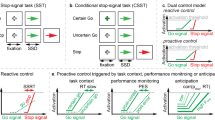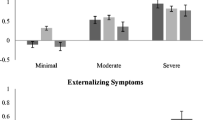Abstract
Research on different subtypes of attention deficit hyperactivity disorder (ADHD) yielded inconsistent results regarding the nature of cognitive deficits. Whereas some studies report significant differences between subtypes, others fail to report these differences. In fact, the majority of studies in the field of ADHD does not differentiate between subtypes at all. The present study adopted the cognitive task of negating valence to compare the DSM-defined ADHD combined subtype (ADHD-C; n = 25), the inattentive subtype (ADHD-I; n = 25) and the control group (n = 30). As a main result, children with ADHD-C showed significant impairments compared to children with ADHD-I and the control group on conscious responses—driven by executive function, as well as on unconscious associative tasks. Medical treatment with stimulants positively influenced cognitive performance, although to a different extent for subgroups. The results are discussed in the context of current theories of ADHD and imply indications for further research in this field.


Similar content being viewed by others
References
Alderson RM, Rapport MD, Kofler MJ (2007) Attention-deficit/hyperactivity disorder and behavioural inhibition: a meta-analytic review of the stop-signal paradigm. J Abnorm Child Psychol 35:745–758
American Psychiatric Association (2000) Diagnostic and statistical manual of mental disorders DSM-IV. American Psychiatric Association, Washington, DC
Arbeitsgruppe Deutsche Child Behavior Checklist (1998) Elternfragebogen über das Verhalten von Kindern und Jugendlichen. Deutsche Bearbeitung der Child Behavior Checklist (CBCL/4-18). Einführung und Anleitung zur Handauswertung (2. Aufl. mit deutschen Normen). Arbeitsgruppe Kinder-, Jugend- und Familiendiagnostik (KJFD), Köln
Barkley RA (1997) Behavioral Inhibition, sustained attention, and executive functions: constructing a unifying theory of ADHS. Psychol Bull 121:65–94
Boonstra AM, Oosterlaan J, Sergeant JA, Buitelaar JK (2005) Executive functioning in adult ADHD: a meta-analytic review. Psychol Med 35:1097–1108
Chhabildas M, Pennington BF, Willcutt EG (2001) A comparison of the neuropsychological profiles of the DSM-IV subtypes of ADHD. J Abnorm Child Psychol 29:529–540
Clarke SD, Kohn MR, Hermens DF, Rabbinge M, Clark CR, Gordon E, Williams LM (2007) Distinguishing symptom profiles in adolescent ADHD using an objective cognitive test battery. Int J Adolesc Med Health 19:355–367
Deutsch R, Gawronski B, Strack F (2006) At the boundaries of automaticity: negation as reflective operation. J Pers Soc Psychol 91:385–405
Döpfner M, Frölich J, Lehmkuhl G (2000) Hyperkinetische Störungen. Hogrefe, Göttingen
Doyle AE, Faraone SV, Seidman LJ, Willcutt EG, Nigg JT, Waldman ID, Pennington BF, Peart J, Biederman J (2005) Are endophenotypes based on measures of executive functions useful for molecular genetic studies of ADHD? J Child Psychol Psychiatry 46:774–803
Evans SW, Smith BH, Gnagy EM, Pelham WE, Bukstein O, Greiner AR, Altenderfer L, Baron-Myak C (2001) Dose-response effects of methylphenidate on ecologically valid measures of academic performance and classroom behavior in adolescents with ADHD. Exp Clin Psychopharmacol 9:163–175
Geurts HM, Verté S, Oosterlaan J, Roeyers H, Sergeant JA (2005) ADHD subtypes: do they differ in their executive functioning profile? Arch Clin Neuropsychol 20:457–477
Gross-Tsur V, Goldzweig G, Landau YE, Berger I, Shmueli D, Shalev RS (2006) The impact of sex and subtypes on cognitive and psychosocial aspects of ADHD. Dev Med Child Neurol 48:901–905
Huang YS, Chao CC, Wu YY, Chen YY, Chen CK (2007) Acute effects of methylphenidate on performance during the Test of Variables of Attention in children with attention deficit/hyperactivity disorder. Psychiatry Clin Neurosci 61:219–225
Johnson BD, Altmaier EM, Richman LC (1999) Attention deficits and reading disabilities: are immediate memory defects additive? Dev Neuropsychol 15:213–226
Lockwood KA, Marcotte AC, Stern C (2001) Differentiation of attention deficit/hyperactivity disorder subtypes: application of a neuropsychological model of attention. J Clin Exp Neuropsychol 23:317–330
Mayo R, Schul Y, Burnstein E (2004) “I am not guilty” vs. “I am innocent”: successful negation may depend on the schema used for its encoding. J Exp Soc Psychol 40:433–449
Melchers P, Preuß U (2003) Kaufman-assessment battery for children. Durchführungs- und Auswertungshandbuch (deutschsprachige Fassung, 6. Aufl.). Swets & Zeitlinger, Frankfurt am Main
Milich R, Ballentine AC, Lynam D (2001) ADHD combined type and ADHD predominantly inattentive type are distinct and unrelated disorders. Clin Psychol Sci Pract 8:463–488
Miller EK, Cohen JD (2001) An integrative theory of prefrontal cortex function. Annu Rev Neurosci 24:167–202
Murphy KR, Barkley RA, Bush T (2001) Executive functioning and olfactory identification in young adults with attention deficit-hyperactivity disorder. Neuropsychology 15:211–220
Nigg JT, Blaskey L, Huang-Pollack C, Rappley MD (2002) Neuropsychological executive functions and ADHD DSM-IV subtypes. J Am Acad Child Adolesc Psychiatry 41:59–66
Nigg JT, Willcut EG, Doyle AE, Sonuga-Barke EJS (2005) Causal heterogenity in attention-deficit/hyperactivity disorder: do we need neuropsychologically impaired subtypes? Biol Psychiatry 57:1224–1230
O’Driscoll GA, Dépatie L, Holahan AL, Savion-Lemieux T, Barr RG, Jolicoeur C, Douglas VI (2005) Executive functions and methylphenidate response in subtypes of attention-deficit/hyperactivity disorder. Biol Psychiatry 57:1452–1460
Pietrzak RH, Mollica CM, Maruff P, Snyder PJ (2006) Cognitive effects of immediate-release methylphenidate in children with attention-deficit/hyperactivity disorder. Neurosci Biobehav Rev 30:1225–1245
Scheres A, Oosterlaan J, Geurts H, Morein-Zamir S, Meiran N, Schut H et al (2004) Executive function in boys with ADHD: primarily an inhibition deficit? Arch Clin Neuropsychol 19:569–594
Solanto MV, Abikoff H, Sonuga-Barke EJS, Schachar R, Logan GD, Wigal T, Hechtman L, Hinshaw S, Turkel E (2001) The ecological validity of delay aversion and response inhibition as measures of impulsitivity in AD/HD: a supplement to the NIMH Multimodal Treatment Study of AD/HD. J Abnorm Child Psychol 29:215–228
Sonuga-Barke EJS (2003) The dual pathway model of AD/HD: an elaboration of neuro-developmental characteristics. Neurosci Biobehav Rev 27:593–604
Sonuga-Barke EJS (2005) Causal models of attention-deficit/hyperactivity disorder: from common simple deficits to multiple developmental pathways. Biol Psychiatry 57:1231–1238
Sonuga-Barke EJS, Dalen L, Remington B (2003) Do executive deficits and delay aversion make independent contributions to preschool attention-deficit/hyperactivity disorder symptoms? J Am Acad Child Adolesc Psychiatry 42:1335–1342
Strack F, Deutsch R (2004) Reflective and impulsive determinants of social behavior. Pers Soc Psychol Rev 8:220–247
Strack F, Werth L, Deutsch R (2006) Reflective and impulsive determinants of consumer behavior. J Consum Psychol 16:205–216
Tewes U, Rossmann P, Schallberger U (eds) (2002) Manual zum HAWIK-III, Übersetzung und Adaptation der WISC-III von David Wechsler. Huber, Bern
Zeeuw P, Aarnoudse-Moens C, Bijlhout J, König C, Uiterweer AP, Papanikolau A, Hoogenraad C, Imandt L, Been D, Sergeant JA, Oosterlaan J (2008) Inhibitory performance, response speed, intraindividual variability, and response accuracy in ADHD. J Am Acad Child Adolesc Psychiatry 47:808–816
Acknowledgment
The authors thank Prof. Dr. Strack and Dr. Deutsch for their inspiring advice and their friendly support as to the programming of the task.
Author information
Authors and Affiliations
Corresponding author
Rights and permissions
About this article
Cite this article
Schwenck, C., Schmiedeler, S., Zenglein, Y. et al. Reflective and impulsive reactions in ADHD subtypes. ADHD Atten Def Hyp Disord 1, 3–10 (2009). https://doi.org/10.1007/s12402-009-0002-6
Received:
Accepted:
Published:
Issue Date:
DOI: https://doi.org/10.1007/s12402-009-0002-6




